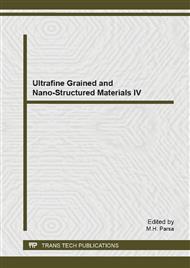[1]
R. Czajka, Development of Medical Textile Market, Fibers Text. East. Eur. 13 (2005) 13-15.
Google Scholar
[2]
S.K. Chinta, K.V. Veena, Impact of Textiles in Medical Field, Int. J. of Latest Trends in Eng. and Tech. 2 (2013) 142-145.
Google Scholar
[3]
Petersen, Nathan, P. Gatenholm, Bacterial cellulose-based materials and medical devices: current state and perspectives, Appl. Microbiol. Biotechnol., 91 (2011) 1277-1286.
DOI: 10.1007/s00253-011-3432-y
Google Scholar
[4]
WK. Czaja , DJ. Young , M. Kawecki , RM Jr. Brown . The future prospects of microbial cellulose in biomedical applications, BioMacromol. 8. 1 (2007): 1-12.
Google Scholar
[5]
C. Zhijiang, J. Kim, Bacterial cellulose/poly (ethylene glycol) composite: characterization and first evaluation of biocompatibility, Cellul. 17. 1 (2010) 83-91.
DOI: 10.1007/s10570-009-9362-5
Google Scholar
[6]
L. Nimeskern, J. Sundberg, P. Gatenholm, R. Muller, K. S. Stok Mechanical evaluation of bacterial nanocellulose as an implant material for ear cartilage replacement, J. Mech. behavior of biome. Mater. (2013).
DOI: 10.1016/j.jmbbm.2013.03.005
Google Scholar
[7]
B. M. Cherian, Alcides Lopes Leão, S. F. de Souza, G. M. de Olyveira, L. M. Manzine Costa, C. V. Seullner Brandão, S. Narine, Bacterial Nanocellulose for Medical Implants, Adv. Nat. Polym., Springer Berlin Heidelberg, (2013) 337-359.
DOI: 10.1007/978-3-642-20940-6_10
Google Scholar
[8]
M. Ul-Islam, T. Khan, W. A. Khattak, J. K. Park, Bacterial cellulose-MMTs nanoreinforced composite films: novel wound dressing material with antibacterial properties, Cellul. (2013) 1-8.
DOI: 10.1007/s10570-012-9849-3
Google Scholar
[9]
Z. Cai, H. Chengwei, Y. Guang, Poly (3-hydroxubutyrate-co-4-hydroxubutyrate)/bacterial cellulose composite porous scaffold: Preparation, characterization and biocompatibility evaluation, Carbohydr. Polym. 87. 2 (2012) 1073-1080.
DOI: 10.1016/j.carbpol.2011.08.037
Google Scholar
[10]
G. Miguel, P. Gatenholm, D. Klemm, Bacterial Cellulose: A Sophisticated Multifunctional Material, CRC Press, 9 (2012).
Google Scholar
[11]
F. G Torres, O. P. Troncoso, C. Torres, C. J. Grande, Cellulose Based Blends, Composites and Nanocomposites, Adv. Nat. Polym., Springer Berlin Heidelberg, (2013) 21-54.
DOI: 10.1007/978-3-642-20940-6_2
Google Scholar
[12]
W. Ch. Lin, Ch. Lien, H. J. Yeh, Ch. M. Yu, Sh. H. Hsu Lin, Bacterial Cellulose and Bacterial Cellulose-Chitosan Membranes for Wound Dressing Applications, Carbohydr. Polym. (2013).
DOI: 10.1016/j.carbpol.2013.01.076
Google Scholar
[13]
S. Saska, L. N. Teixeira, P. Tambasco de Oliveira, A. M. Minarelli Gaspar, S. JoséLima Ribeiro, Y. Messaddeqa, R. Marchettoa, Bacterial cellulose-collagen nanocomposite for bone tissue engineering, J. Mater. Chem. 22. 41 (2012) 22102-22112.
DOI: 10.1039/c2jm33762b
Google Scholar
[14]
P. Chen, J. Lai, H. Hsiao, Y. Chu, Ch. Liao, U.S. Patent 20, 120, 308, 649 (2012).
Google Scholar
[15]
Belgacem, M. Naceur, and A. Gandini, eds. Monomers, polymers and composites from renewable resources, Access Online via Elsevier, (2011).
Google Scholar
[16]
A. Meftahi, R. Khajavi, A. Rashidi, M. Sattari, M. E. Yazdanshenas, M. Torabi, The effects of cotton gauze coating with microbial cellulose, Cellul. 17. 1 (2010)199-204.
DOI: 10.1007/s10570-009-9377-y
Google Scholar


